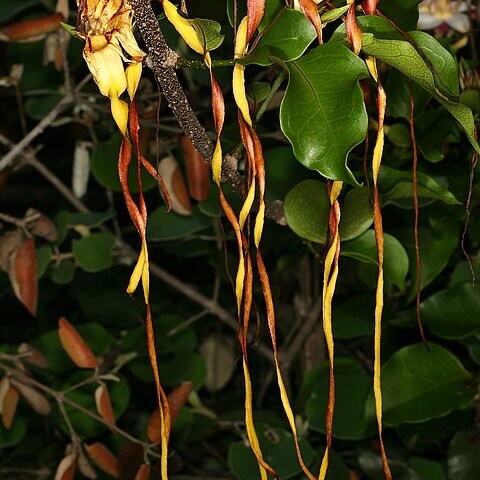Sarmentose shrub or liana, 1–15 m long, deciduous, flowers appearing with or rarely before the leaves; trunk to 10 cm in diameter, bark pale grey; branches with corky flattened triangular protuberances to 2.5 cm high at the nodes or rarely in between; branches glabrous or rarely puberulous; latex white or reddish.. Leaves petiolate, blade elliptic or ovate, 3–11 cm long, 1.7–5 cm wide, base cuneate or rounded, apex acuminate, glabrous or very rarely sparsely puberulous; petiole 2–13 mm long.. Inflorescence 1–4-flowered, sessile or pedunculate, glabrous or occasionally puberulous in its parts; pedicels 3–11 mm long.. Flowers fragrant, white turning yellow, near the mouth outside and tails outside red; sepals unequal, ovate or narrowly elliptic, 5–21 mm long, acute; corolla tube 13–37 mm long, corolla lobes ovate, 9–16 mm long, 6–15 mm wide, narrowing into the 8–20 cm long pendulous tails, corona lobes 6–15 mm long.. Fruit dark brown, hard, the mericarps ± opposite-divergent, narrowly ovoid, 20–37 cm long, 2–3.5 cm in diameter, tapering to an obtuse point or small knob, lenticellate, glabrous; seeds 10–18 mm long, densely pubescent, with a stalked coma 6–16 cm long.
Leaves petiolate; petiole (2)3—13 mm. long; lamina dark green, paler beneath, elliptic or ovate, 1·3–3(3·4) times as long as wide, 2·8–11 x 1·7–5·2 cm., cuneate or rounded at the base or decurrent into the petiole, acuminate at the apex (acumen 2–10 mm. long, obtuse), sometimes recurved at the margin, papyraceous or less often thinly coriaceous, glabrous or exceptionally sparsely puberulous, with 4–6(8) pairs of secondary veins; tertiary venation conspicuous, especially beneath.
Corolla tube (13)15–37 mm. long and widening at 1/5–2/5 of its length into a cyathiform upper part, at the mouth 10–29 mm. wide, glabrous outside and puberulous inside; corona lobes narrowly triangular and often undulate, 6–15 x 1·7–4 mm., glabrous; corolla lobes ovate, 9–16 x 6–15 mm., gradually narrowing into the pendulous tails; lobes (including the tails) 90–205 mm. long, glabrous on both sides.
Shrub or climber. Flower parts and branchlets glabrous. Calyx lobes 10-15 mm long and 2-3 mm broad. Corolla lobes pendulous, 60-140 mm long. Plumose awn on seed with naked stalk 20-30 mm long. Flowers whitish to cream within tube and on inner sides of lobes, reddish purple without.
Follicles divergent at an angle of 180°, tapering towards the apex and ending in a narrow obtuse point or in a small knob, 20–37 cm. long and 2·2–3·5 cm. in diam.; exocarp dark brown, thick and hard, glabrous, sparsely or densely lenticellate, rarely not lenticellate.
Trunk up to 10cm. in diam., pale grey; branches at the nodes (or less often in between), with 2–4 corky laterally compressed triangular protuberances up to 25 mm. high; branchlets glabrous or rarely puberulous.
Stamens included for 1·5–11 mm., rarely 0–1·5 mm. exserted; filaments straight or nearly so, 2·6–5·2 mm. long; anthers 6–10 x 1·1–2 mm., glabrous; acumen 1–4 mm. long.
Inflorescence 1–2(4)-flowered, sessile or pedunculate, glabrous or occasionally puberulous in all parts; pedicels 3·5–11 mm. long; bracts sepal-like or subscarious.
Seeds with the grain 10–18 x 2·8–4 x 1 mm., densely pubescent; rostrum glabrous for (20–)35–65 mm. and bearing a coma for 10–52 mm.; coma (38)60–90 mm. long.
Sarmentose shrub or liana, 1–15 m. high, deciduous, flowers appearing with or rarely before the leaves; latex — if present — white or reddish.
Sepals erect or spreading, fairly unequal, ovate or narrowly elliptic, 5–21 x 2–5·5 mm., acute, glabrous or exceptionally puberulous.
Ovary 0·8–2·6 x 1·5–2·8 mm., glabrous; style 7·5–14·5 mm. long; clavuncula 1·8–2·8 x 1·3–2·3 mm.; stigma minute.
Flowers fragrant.

